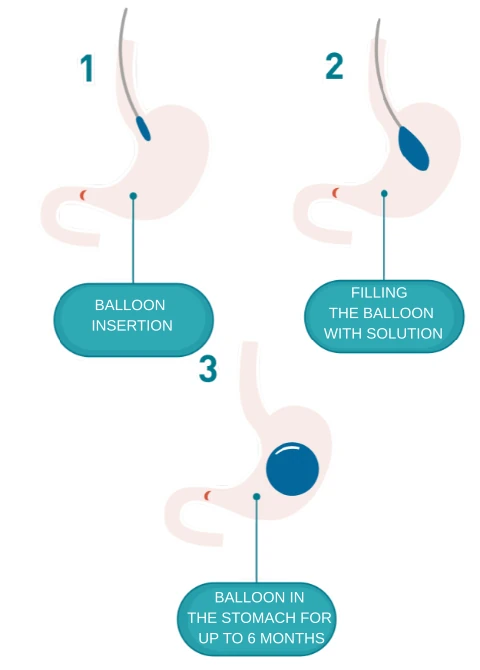Obesity treatment
“Take control of your weight and entrust yourself to the hands of experts.”
Obesity is one of the greatest challenges faced by modern society. A combination of lack of physical activity and excessive consumption of energy-dense foods creates the perfect environment for this condition, which can have serious consequences for health. These consequences include high blood pressure, diabetes, high cholesterol, and an increased risk of stroke and heart attack. These health complications can severely affect both the quality and longevity of life.
But don’t give up! Every journey towards a healthier life begins with the determination to make a change. If traditional diets have let you down—being complicated, ineffective, or difficult to maintain—you don’t have to face it alone. There is a modern, medically-proven method that can help you achieve the desired weight loss success: the intragastric balloon.
Intragastric balloon:
- This innovative procedure not only effectively supports weight loss but also helps guide you towards a healthier lifestyle. The balloon, made from high-quality silicone, is introduced non-invasively through the mouth and esophagus into the stomach. It is then filled with a saline solution to occupy approximately 70% of the stomach’s volume. The goal of this process is to reduce your feelings of hunger, speed up the sensation of fullness, and change your relationship with food.
- The intragastric balloon is more than just a medical device – it is the key to learning to listen to your body, adopting healthier habits, and opening the door to the life you desire. This method has already helped thousands of people worldwide—and it can help you too.
„Take the first step towards a healthier future!“
- he procedure involves the insertion of an inflated silicone balloon through your mouth, esophagus, and into the stomach. Once the balloon is in place, it is filled with a saline solution. The balloon occupies approximately 70% of your stomach’s volume. The function of the balloon is to reduce hunger, increase the speed of satiety, and change your personal relationship with food.
- For the first 2-4 days after implantation, the patient may experience nausea, potential vomiting, or stomach discomfort. These are normal symptoms that will spontaneously resolve. The intragastric balloon is inserted for a period of 6, or 12 months, depending on the type of balloon. After this time, the balloon is removed in the same way it was inserted. Over a period of 6 months, a patient can lose up to 35 kg.
If your body mass index (BMI) is 27 or higher, you are eligible for this procedure.
We offer intragastric balloon Orbera® from Boston Scientific.
Orbera®
- Inserted during a gastroscopy
- Insertion period: 6 months
The balloon is inserted during a gastroscopic examination and is removed endoscopically after the insertion period.
Orbera 365®
- Inserted during a gastroscopy
- Insertion period: 12 months
The balloon is inserted during a gastroscopic examination and is removed endoscopically after the insertion period.
Pharmacological Treatment
Pharmacological treatment of obesity is indicated for patients who have not achieved significant weight loss through lifestyle changes or when obesity poses a high health risk. Its goal is to support weight reduction, improve metabolic parameters, and reduce the risk of comorbidities such as type 2 diabetes, cardiovascular diseases, or hypertension.
Who is it suitable for?
- Individuals with BMI ≥30 (obesity) or ≥27.
- Patients motivated for long-term lifestyle changes.
- Those who do not tolerate or cannot achieve results with diet and exercise alone.
Why is pharmacotherapy beneficial?
It aids in weight loss when combined with dietary and physical activity interventions, increasing patient adherence and improving overall health outcomes. The choice of medication depends on individual needs, comorbidities, and treatment tolerance. Pharmacological treatment should always be part of a comprehensive approach, including nutritional therapy, physical activity, and behavioral intervention, under the supervision of a specialist.
1. Liraglutide (GLP-1 receptor agonist)
-
-
- Mechanism: Enhances satiety and slows gastric emptying.
- Indication: overweight/obesity
- Advantages: Improves glycemic control in diabetics.
- Side effects: Nausea, vomiting.
-
2. Tirzepatide (GLP-1/GIP receptor agonist)
-
-
- Mechanism: Enhances satiety, reduces appetite, and slows gastric emptying.
- Indication: overweight/obesity.
- Advantages: Promotes weight loss and improves glycemic control.
- Side effects: Nausea, vomiting, occasional digestive issues.
-
